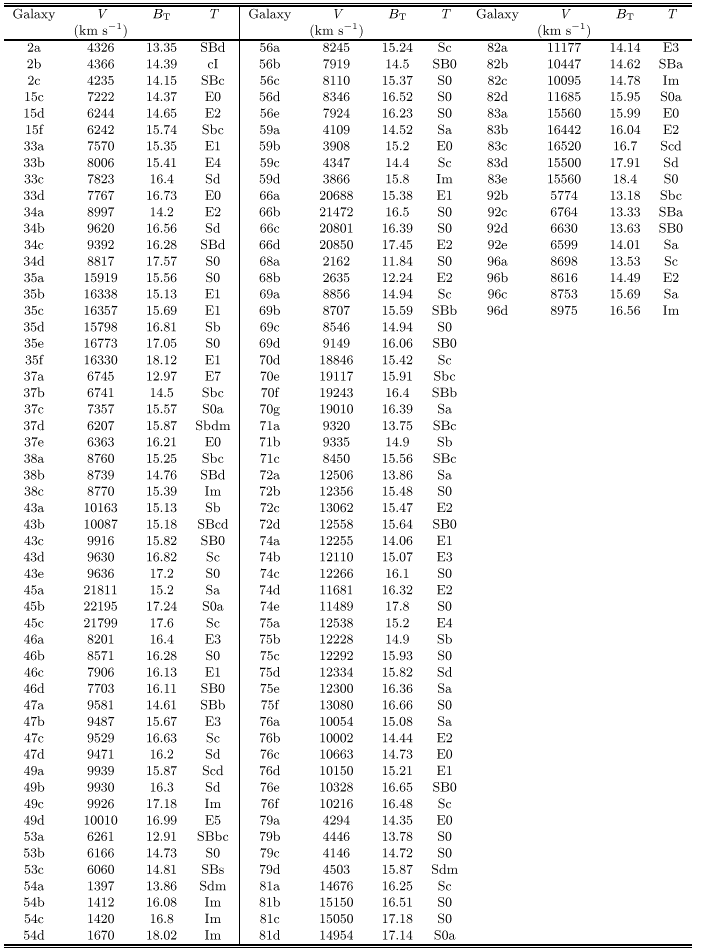

Up: An H catalogue of
The 100 compact groups catalogue by
Hickson (1982) has been revised by
Hickson et al. (1989)
and then by
Hickson et al. (1992).
By adding a radial velocity criterion
Hickson et al. (1992)
were able to reject probable non member galaxies.
The resulting sample consists of 92 groups each containing three or more "accordant"
members, which have radial velocities differing by no more than 1000 km s-1 from
the median velocity of the group. Our sample has been drawn from this latest catalog.
In this paper, the result of the data reduction and calibration of H CCD
images are presented for 31 Hickson Compact Groups. The remaining 61 HCGs were not in
our sample because the adequate H
CCD
images are presented for 31 Hickson Compact Groups. The remaining 61 HCGs were not in
our sample because the adequate H interferometric filters were not available
during the observations. This is the only criterion used to select the observed
groups.
interferometric filters were not available
during the observations. This is the only criterion used to select the observed
groups.
The redshift of observed groups is in the range  (Hickson et al. 1992)
and their distribution is shown in Fig. 1
(the width of each bin is 0.01).
(Hickson et al. 1992)
and their distribution is shown in Fig. 1
(the width of each bin is 0.01).
![\begin{figure}
\includegraphics [width=8.5cm,height=9cm,clip]{redshift.ps}\end{figure}](/articles/aas/full/1999/12/ds8462/Timg7.gif) |
Figure 1:
Redshift distribution of the 31 observed groups |
Table 1:
Observed Hickson Compact Groups
(Hickson et al. 1992): HCG number, right ascension and declination
(1950), number of accordant galaxies, velocity dispersion and mean redshift of
group
|
|
Table 1 lists the observed HCGs as follows:
Column 1: Name of the groups according to Hickson's catalogue;
Column 2: 1950 right ascension (R.A.) of the centroid of the member galaxies;
Column 3: 1950 declination (Dec.) of the centroid of the member galaxies;
Column 4: Number of accordant members of the group;
Column 5: Velocity dispersion of the group: 
 ;
;
Column 6: Mean Redshift of the group.
The sample is composed of 134 galaxies, 127 out of which have been observed. 52 of
them are Ellipticals and Lenticulars and the remaining 48
of
them are Ellipticals and Lenticulars and the remaining 48 are Spirals and
Irregulars. For each observed galaxy we report in Table 2 the heliocentric
radial velocity V in units of km s-1, the total magnitude in the photografic
band
are Spirals and
Irregulars. For each observed galaxy we report in Table 2 the heliocentric
radial velocity V in units of km s-1, the total magnitude in the photografic
band  , corrected for internal and galactic extinction and the Hubble type,
as in
Hickson 1993.
Galaxies are named with the number of HCG plus letter
of galaxy itself.
, corrected for internal and galactic extinction and the Hubble type,
as in
Hickson 1993.
Galaxies are named with the number of HCG plus letter
of galaxy itself.
The distribution of the total  magnitude of the observed galaxies is shown
in Fig. 2 (the width of each bin is 0.5 mag).
magnitude of the observed galaxies is shown
in Fig. 2 (the width of each bin is 0.5 mag).
![\begin{figure}
\includegraphics [width=8.5cm,height=9cm,clip]{magnitudine.ps}\end{figure}](/articles/aas/full/1999/12/ds8462/Timg12.gif) |
Figure 2:
Distribution of  magnitude of the 127 observed
galaxies magnitude of the 127 observed
galaxies |
Table 2:
Principal features of the observed galaxies
(Hickson 1993):
galaxy name, heliocentric velocity of group, total photographic blue magnitude,
morphological type of galaxy
 |


Up: An H catalogue of
Copyright The European Southern Observatory (ESO)
![]() CCD
images are presented for 31 Hickson Compact Groups. The remaining 61 HCGs were not in
our sample because the adequate H
CCD
images are presented for 31 Hickson Compact Groups. The remaining 61 HCGs were not in
our sample because the adequate H![]() interferometric filters were not available
during the observations. This is the only criterion used to select the observed
groups.
interferometric filters were not available
during the observations. This is the only criterion used to select the observed
groups.
![]() (Hickson et al. 1992)
and their distribution is shown in Fig. 1
(the width of each bin is 0.01).
(Hickson et al. 1992)
and their distribution is shown in Fig. 1
(the width of each bin is 0.01).

![]() of
them are Ellipticals and Lenticulars and the remaining 48
of
them are Ellipticals and Lenticulars and the remaining 48![]() are Spirals and
Irregulars. For each observed galaxy we report in Table 2 the heliocentric
radial velocity V in units of km s-1, the total magnitude in the photografic
band
are Spirals and
Irregulars. For each observed galaxy we report in Table 2 the heliocentric
radial velocity V in units of km s-1, the total magnitude in the photografic
band ![]() , corrected for internal and galactic extinction and the Hubble type,
as in
Hickson 1993.
Galaxies are named with the number of HCG plus letter
of galaxy itself.
, corrected for internal and galactic extinction and the Hubble type,
as in
Hickson 1993.
Galaxies are named with the number of HCG plus letter
of galaxy itself.
![]() magnitude of the observed galaxies is shown
in Fig. 2 (the width of each bin is 0.5 mag).
magnitude of the observed galaxies is shown
in Fig. 2 (the width of each bin is 0.5 mag).
